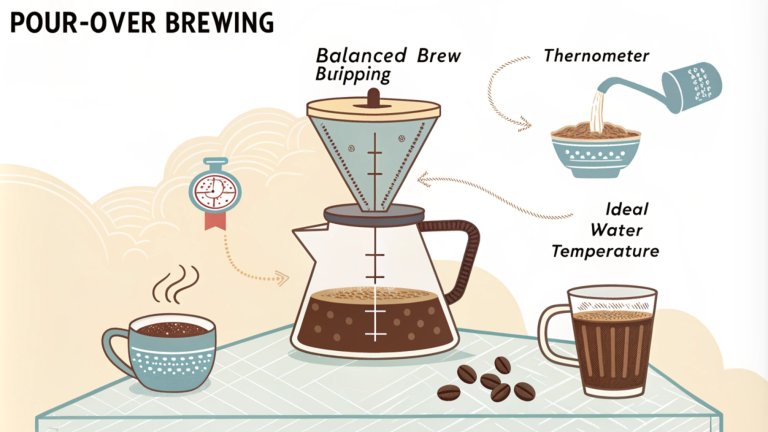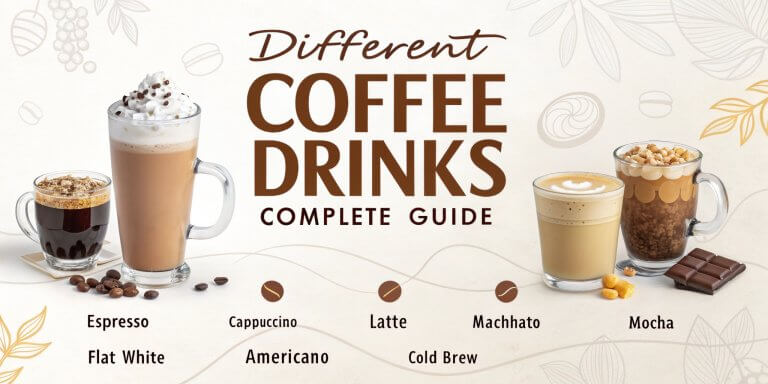
The caffeine in nitro cold brew vs regular coffee debate has coffee lovers everywhere asking essential questions about their daily fuel. You’re not alone if you’ve found yourself staring at two different coffee options, wondering which one will give you the energy boost you need. Get ready for a surprise – Nitro Cold Brew packs a potent caffeine punch that can transform your morning routine.
This comprehensive comparison serves as your guide to understanding exactly what you’re getting in each cup. We’ll break down the numbers, explore the health benefits, and most importantly, help you make informed decisions about your caffeine intake. Whether you’re a busy professional seeking maximum energy or someone concerned about staying within healthy limits, this guide covers everything you need to know about caffeine in nitro cold brew versus regular coffee.
How Much Caffeine Is in Nitro Cold Brew
Nitro cold brew delivers significantly more caffeine than most people expect. The nitrogen infusion process and cold brewing method produce a concentrated beverage that can dramatically boost your energy levels.
Starbucks Nitro Cold Brew Caffeine Content
Starbucks Nitro Cold Brew contains 280mg of caffeine in a 16-ounce grande serving. This makes it one of the most caffeinated beverages on their menu. The 12-ounce tall size delivers 215mg of caffeine, which is still substantial for a smaller serving.
The caffeine in nitro cold brew versus regular coffee becomes even more interesting when you consider customizations. Adding sweet cream to your nitro cold brew reduces the caffeine content slightly to 265mg per grande. Other variations include the Reserve Nitro Cold Brew, which is available at 400mg per grande, and specialty flavors like Cold Foam Dark Mocha, which contains 290mg.
Starbucks doesn’t offer nitro cold brew in venti sizes because the drink loses its signature cascading effect and creamy texture in larger volumes. This size limitation is a deliberate choice to help you manage your caffeine intake, preventing excessive doses that could exceed the recommended daily limit. It’s a step towards a more responsible and enjoyable coffee experience.
Other Popular Nitro Cold Brew Brands
Rise Brewing Company offers canned nitro cold brew with 215mg of caffeine in a 9.6-ounce can. This comparison highlights the varying approaches different brands take to caffeine content in their nitro products. Many grocery store brands now offer ready-to-drink nitro options with varying caffeine levels.
Coffee shops beyond Starbucks have adopted nitro cold brew, incorporating their unique caffeine formulations. Local cafes often brew their nitro coffee with varying coffee-to-water ratios, which affects the final caffeine content. Some specialty shops create extra-strong versions that can reach 300mg or more per 16-ounce serving.
Canned nitro products typically contain between 180-250mg of caffeine per 12-ounce serving. The convenience of grab-and-go options has made these products popular among busy consumers who want consistent caffeine levels without having to visit a coffee shop. It’s a testament to the industry’s commitment to catering to your needs and lifestyle.
Factors Affecting Nitro Cold Brew Caffeine
The cold brewing process uses a higher coffee-to-water ratio than traditional hot brewing methods. Most nitro cold brew recipes call for a 1:4 coffee-to-water ratio, compared to the 1:15 ratio standard in drip coffee. This concentration difference directly impacts the caffeine in nitro cold brew vs regular coffee comparisons.
Bean selection plays a crucial role in the final caffeine content. Robusta beans contain nearly twice the caffeine of Arabica beans. Many nitro cold brew producers use blends that include some Robusta to boost caffeine levels and create a stronger flavor profile.
Brewing time also affects extraction. Cold brew steeps for 12-24 hours, allowing for maximum caffeine extraction from the grounds. The extended contact time between water and coffee grounds ensures that more caffeine dissolves into the final product than with quick brewing methods.
A comparison reveals that nitro cold brew has significantly higher caffeine levels than regular coffee.
How Much Caffeine Is in Regular Coffee
Understanding the caffeine content in regular coffee is equally important. While it contains significantly less caffeine than nitro cold brew, the exact amount varies based on brewing method and serving size. This knowledge empowers you to make balanced choices about your daily caffeine intake.
Average Caffeine in Regular Coffee
A standard 16-ounce cup of regular drip coffee contains approximately 188mg of caffeine. This translates to approximately 11.8 mg of caffeine per fluid ounce, which is considerably less concentrated than Nitro Cold Brew. An 8-ounce cup, which many consider a standard serving, contains 80-100mg of caffeine.
The brewing method has a significant impact on caffeine extraction in regular coffee. French press coffee tends to have slightly higher caffeine levels due to longer steeping time. Drip coffee makers produce consistent results, while pour-over methods can vary based on technique and timing.
Home brewing presents challenges for consistent caffeine levels. Factors such as grind size, water temperature, and brewing time all affect the extraction process. Many home brewers unknowingly create weaker coffee than commercial establishments, resulting in lower caffeine content than expected.
Popular Coffee Shop Regular Coffee
Starbucks Pike Place Roast contains 310mg of caffeine in a 16-ounce grande size. This exceeds many nitro cold brew options and highlights the significant variation in caffeine content among regular coffees. However, this represents one of their stronger regular coffee options.
Dunkin’ regular coffee averages around 210mg per 16-ounce serving. Independent coffee shops often have inconsistent caffeine levels because they use different brewing methods and coffee-to-water ratios. Some specialty shops focus on flavor over caffeine content, while others cater to customers seeking maximum energy.
Chain restaurants typically standardize their brewing processes to ensure consistent caffeine levels. This standardization helps customers know what to expect, but it also means less variation in strength and flavor profiles compared to independent establishments.
Why Nitro Cold Brew Has More Caffeine
Another consideration for environmentally conscious consumers is the use of single-use cans or bottles for nitro cold brew. While convenient, these containers contribute to the accumulation of plastic waste. Opting for a reusable container or supporting brands that use sustainable packaging can help reduce your environmental impact.
The Cold Brew Base Advantage
Cold brewing requires 12-24 hours of steeping time, allowing for maximum caffeine extraction from coffee grounds. This extended contact time enables the extraction of more caffeine from the beans than hot brewing methods, which rely on heat for rapid extraction. The slow extraction process yields a concentrate that serves as the base for nitro cold brew.
Cold water extraction works differently from hot water methods. While hot water quickly dissolves caffeine, chilly water extraction is more selective, pulling caffeine while leaving behind some of the compounds that create bitterness. This selective extraction yields a smoother taste with a higher concentration of caffeine.
Higher coffee-to-water ratios are standard in cold brew preparation. Most cold brew recipes use a 1:4 or 1:5 ratio, compared to the 1:15 ratio in drip coffee. This concentration difference directly translates to higher caffeine levels in the final product.
Nitrogen Infusion Effects on Caffeine
Nitrogen infusion doesn’t add caffeine, but it affects how we perceive the drink’s strength. The creamy texture and visual appeal can make the high caffeine content more palatable, encouraging consumption of larger quantities. The nitrogen also prevents dilution from ice, maintaining the concentrated caffeine levels.
The infusion process preserves the cold brew concentrate without diluting it. Traditional iced coffee often gets diluted with ice, reducing the effective caffeine concentration. Nitro cold brew maintains its full strength throughout the drinking experience.
Nitrogen creates a smoother mouthfeel that masks the intensity of high caffeine content. This can lead to faster consumption and higher total caffeine intake compared to regular coffee, which might be sipped more slowly due to its harsher taste or higher temperature.
Brewing Method Comparison
Temperature plays a crucial role in determining the speed and efficiency of caffeine extraction. Hot brewing extracts caffeine quickly but also pulls other compounds that can create bitterness. Cold brewing’s slow extraction process allows for the selective dissolution of caffeine while minimizing harsh flavors.
Time versus temperature represents a trade-off in brewing methods. Hot coffee brewing takes minutes, but it extracts less total caffeine due to the shorter contact time between the coffee and the water. Cold brew takes hours but achieves higher extraction rates through extended steeping.
The science behind the superiority of cold brew lies in its extraction chemistry. Cold water dissolves caffeine effectively, given enough time, while hot water creates a rushed extraction that may not maximize caffeine yield from the grounds.
Health Benefits and Risks Comparison
The caffeine in nitro cold brew vs regular coffee affects your health differently due to concentration levels and additional compounds. Both beverages offer benefits, but understanding the differences helps you make better choices for your health goals.
Shared Health Benefits
Both nitro cold brew and regular coffee provide similar antioxidant benefits. Coffee contains chlorogenic acids and other compounds that support cellular health and may reduce inflammation. These antioxidants remain stable in both hot and cold brewing methods.
Cognitive enhancement occurs with both beverages due to their caffeine content. The stimulant effects improve alertness, focus, and mental clarity regardless of brewing method. Both options can support productivity and cognitive performance when consumed in appropriate amounts.
Disease prevention benefits appear in both nitro cold brew and regular coffee consumption. Studies suggest coffee drinking may reduce the risks of type 2 diabetes, certain cancers, and neurodegenerative diseases. The protective effects come from both caffeine and other bioactive compounds present in coffee.
Nitro Cold Brew Specific Benefits
Lower acidity gives nitro cold brew a significant advantage for digestive health. Cold brew contains approximately 60% less acid than hot-brewed coffee, making it gentler on sensitive stomachs. This reduction in acidity can prevent acid reflux and digestive discomfort.
Natural sweetness in nitro cold brew reduces the need for added sugars. The cold brewing process extracts natural sugars from coffee beans while minimizing the presence of bitter compounds. This natural sweetness can help reduce overall sugar intake when compared to regular coffee, which often requires sweeteners.
The smooth texture eliminates the need for dairy additions in many cases. The nitrogen infusion creates a creamy mouthfeel that can satisfy those who typically add milk or cream to their coffee. This can reduce calorie intake and avoid dairy-related digestive issues.
Caffeine Safety Considerations
Daily caffeine limits recommend no more than 400mg for healthy adults. A single 16-ounce nitro cold brew at 280mg represents 70% of this daily limit, leaving little room for other caffeinated beverages or foods. This high concentration requires careful consideration of total daily intake.
Sensitive individuals should approach nitro cold brew with caution due to its high caffeine content. Those with anxiety, heart conditions, or caffeine sensitivity may experience adverse effects from the concentrated caffeine levels. Starting with smaller portions helps assess individual tolerance.
Pregnant women should limit their caffeine intake to 200 milligrams daily. A single serving of nitro cold brew exceeds this recommendation, making it unsuitable for pregnant individuals. Regular coffee in smaller portions provides a safer option for expecting mothers.
2025 Functional Additives Trend
Adaptogens and nootropics are increasingly being added to nitro cold brew products. These functional ingredients help balance caffeine’s stimulating effects while providing additional health benefits. Popular additions include ashwagandha, lion’s mane mushroom, and L-theanine.
CBD and probiotic innovations are emerging in the nitro coffee market. These additions aim to create beverages that support overall wellness beyond basic caffeine delivery. However, regulatory considerations and consumer education remain essential factors in this trend.
The health-focused evolution of the market reveals that consumers are seeking more than just caffeine from their coffee. Functional beverages that combine high caffeine content with beneficial additives represent a growing segment of the nitro cold brew market.
Taste and Texture Differences
The sensory experience of caffeine in nitro cold brew vs regular coffee extends far beyond just caffeine content. These differences have a significant impact on enjoyment and consumption patterns.
Nitro Cold Brew Sensory Profile
The creamy, velvety mouthfeel is achieved through nitroinfusion, which creates tiny bubbles throughout the beverage, resulting in a smooth texture. This texture mimics dairy products without adding calories or affecting the caffeine content. The soft texture makes high caffeine levels more palatable and enjoyable.
Natural sweetness reduces the bitterness typically associated with high-caffeine beverages. The cold brewing process extracts sugars while minimizing bitter compounds, creating a naturally balanced flavor. This sweetness can make the strong caffeine content less overwhelming.
Visual appeal adds to the overall experience through the cascading effect when poured. The nitrogen creates a dramatic visual presentation that enhances the drinking experience. This aesthetic factor contributes to the premium perception and willingness to pay higher prices.
Regular Coffee Characteristics
Traditional flavor profiles in regular coffee include more pronounced acidity and bitterness. Hot brewing extracts a broader range of compounds, creating complex flavor notes that coffee enthusiasts appreciate. However, these flavors can be harsh for some drinkers, especially at higher caffeine concentrations.
Temperature affects taste perception significantly in regular coffee. Hot beverages suppress some taste receptors while enhancing others, changing how we perceive sweetness and bitterness. This temperature effect doesn’t occur with cold nitro beverages.
Brewing method variations create diverse flavor profiles in regular coffee. French press, pour-over, and drip methods each produce different taste characteristics while maintaining similar caffeine levels. This variety allows for matching personal preferences.
Consumer Preference Trends
Millennials and Gen Z consumers exhibit a strong preference for nitro cold brew, driven by its Instagram-worthy appearance and smooth taste. These demographics value both function and form in their beverage choices, making nitro cold brew particularly appealing.
Social media has a significant impact on coffee selection decisions. The visual appeal of nitro cold brew makes it highly shareable content, driving consumer interest and trial. This trend affects how coffee shops market their high-caffeine options.
Seasonal consumption patterns indicate that nitro cold brew is gaining popularity year-round, rather than just during warm months. The smooth texture and high caffeine content appeal to consumers regardless of the weather, expanding the market beyond traditional cold beverage seasons.
Cost Analysis and Value Comparison
Understanding the financial implications of choosing nitro cold brew with caffeine vs. regular coffee helps you make informed decisions about your coffee budget. The premium pricing reflects both the production costs and market positioning.
Coffee Shop Pricing
Premium pricing positions Nitro Cold Brew at $4-6 per serving compared to $2-4 for regular coffee. This price difference reflects the more complex preparation process and higher perceived value. However, the cost per milligram of caffeine can favor nitro cold brew due to its higher concentration of caffeine.
The cost per milligram of caffeine shows that nitro cold brew is approximately $0.018, compared to regular coffee at $0.021.
This calculation reveals that despite higher upfront costs, nitro cold brew can provide better value for caffeine seekers. The higher concentration means you get more stimulation for your dollar.
Value proposition assessment requires considering both immediate costs and consumption patterns. If you typically buy multiple regular coffees to achieve your desired caffeine levels, a single nitro cold brew is a more economical option. Option: The satisfaction factor also affects perceived value.
Home Brewing Economics
Equipment investment for nitro cold brew ranges from $50 to $500, depending on the system’s sophistication. Simple whipped cream dispensers can create nitro effects for around $50, while professional-grade systems cost several hundred dollars. This upfront investment must be weighed against long-term savings.
Long-term cost benefits become apparent with regular consumption. Home-brewed nitro cold brew costs approximately $0.75 per 16-ounce serving compared to $5.50 at coffee shops. Heavy consumers can recover equipment costs within months through savings.
Quality versus convenience trade-offs influence economic decisions. Home brewing requires time and effort, but provides significant cost savings and customization options. Busy lifestyles may make the convenience of purchasing prepared drinks worth the premium price.
Home Brewing Methods
Creating caffeine in nitro cold brew vs regular coffee at home offers control over strength, flavor, and costs. Understanding the equipment and techniques is essential for achieving consistent results.
Making Nitro Cold Brew at Home
The whipped cream dispenser offers an affordable entry point into home brewing, priced at $30-$ 50. This technique uses N2O cartridges to create the nitrogen infusion effect. While not identical to commercial nitrogen systems, it produces a similar texture and visual impact.
Professional systems designed for home use range from $200 to $500 and provide an authentic nitro cold brew experience. These systems utilize actual nitrogen gas and produce results nearly identical to those of coffee shop versions. The investment makes sense for daily Nitro Cold Brew consumers.
Equipment requirements include cold brew concentrate, nitrogen source, and proper storage containers. Maintenance involves regular cleaning and occasional replacement of parts. The learning curve is minimal, but consistency takes practice and attention to detail.
Cold Brew Base Preparation
Optimal coffee-to-water ratios for cold brew concentrate typically range from 1:4 to 1:5. This concentration creates a strong base that can handle dilution from ice or mixing with other ingredients. The higher ratio is essential for achieving the caffeine levels found in commercial nitro cold brew.
Steeping time recommendations range from 12 to 24 hours for optimal extraction. Longer steeping generally produces a stronger concentrate with higher caffeine content. Room-temperature steeping works fine, although some prefer refrigerated steeping for food safety reasons.
Straining and storage best practices ensure quality and safety. Using fine-mesh strainers or coffee filters effectively removes grounds. Proper storage in refrigerated containers maintains freshness for up to two weeks, allowing for batch preparation and consistent availability.
Market Trends and Future Outlook
The caffeine landscape in nitro cold brew versus regular coffee continues to evolve as consumer preferences and technology advance. Understanding these trends helps predict future developments in the coffee industry.
2025 Industry Developments
Market expansion projections indicate that the nitro cold brew segment is expected to grow from $1.5 billion to $5.2 billion by 2033. This explosive growth reflects the increasing acceptance of consumers and market penetration. The 15.2% compound annual growth rate indicates that strong momentum is expected to continue into 2025.
The growth of the ready-to-drink segment drives much of the market expansion. Convenient packaging and improved shelf stability make nitro cold brew more accessible to a broader consumer base. Grocery store availability removes barriers to trial and regular consumption.
Sustainability initiatives increasingly influence product development and marketing. Consumers expect environmentally responsible packaging and sourcing practices. Companies that invest in sustainable practices gain a competitive advantage in the premium coffee market.
Consumer Behavior Evolution
Health-conscious trends accelerate demand for beverages with functional benefits beyond caffeine. Consumers seek products that support overall wellness while providing energy. This trend drives innovation in functional additives and cleaner ingredient profiles.
Convenience versus quality preferences continue shifting toward premium options that save time. Busy lifestyles drive demand for high-quality, ready-to-consume products. The willingness to pay premiums for convenience and quality supports continued market growth.
Regional market development is showing an expanding availability beyond urban centers. Smaller cities and rural areas increasingly have access to nitro cold brew options. This geographic expansion significantly broadens the potential customer base.
Wrapping Up Your Caffeine Journey
The caffeine comparison between nitro cold brew and regular coffee reveals significant differences that impact your daily energy and health decisions. Nitro cold brew delivers 49% more caffeine per serving while providing a smoother, less acidic experience that many find more enjoyable.
Your caffeine needs and health considerations should guide your choice between these options. If you seek maximum energy in a single serving and can tolerate high caffeine levels, Nitro Cold Brew offers excellent value. Those who prefer moderate caffeine intake or multiple smaller servings throughout the day may find regular coffee more suitable.
The premium pricing of nitro cold brew reflects its concentrated nature and the complexity of its preparation process. However, the cost per milligram of caffeine can favor nitro options for individuals who consume large amounts of caffeine. Home brewing equipment provides long-term savings for regular nitro cold brew drinkers.
Future market trends indicate continued growth and innovation in the nitro cold brew segment. Functional additives and sustainable practices will likely shape product development. Whether you choose nitro cold brew or regular coffee, understanding the caffeine content helps you make informed decisions that support your energy needs and health goals.






